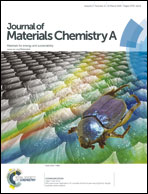Cobalt phosphide as a highly active non-precious metal cocatalyst for photocatalytic hydrogen production under visible light irradiation†
Abstract
Cobalt phosphide (Co2P) is found, for the first time, to be a novel cocatalyst for efficient photocatalytic hydrogen evolution for a system containing CdS nanorods as a photocatalyst and DL-mandelic acid as an electron donor in water. Under optimal conditions, the H2-production rate can reach up to 19 373 μmolh−1 g−1 after 10 h of LED light irradiation. Meanwhile, DL-mandelic acid can be oxidized to benzoylformic acid by the photo-generated holes of CdS nanorods, providing a green and economic way to synthesize benzoylformic acid from DL-mandelic acid.


 Please wait while we load your content...
Please wait while we load your content...